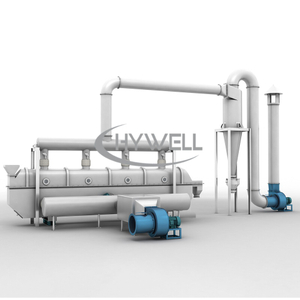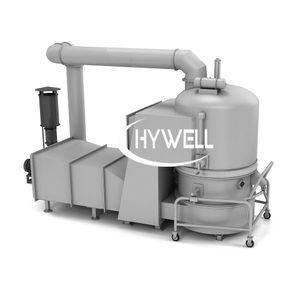Static Fluid Bed Dryers Introduction
Hywell Machinery Static fluid bed dryers and coolers are ideal for products that are free-flowing. This type of dryer is referred to as a static fluid bed because the dryer remains stationary during operation. The static system provides an effective method of drying relatively free-flowing particles with a reasonable narrow particle size distribution. The feed may take the form of powders, granules, crystals, seeds, pre-forms, and agglomerates. A static fluidized bed dryer can be continuous or batch operation and may be round or rectangular. Because there is no mechanical drive system to move the product, the static dryers are lighter and simpler to manufacture – and hence cheaper than the dynamic fluid-bed dryers/coolers. Utilizing a multi-zone scheme allows each section of the fluid bed dryer to have independent temperature and airflow control. Each zone can support a different heating/cooling phase.
Units in continuous and batch types for more uniform materials that do not tend to agglomerate.
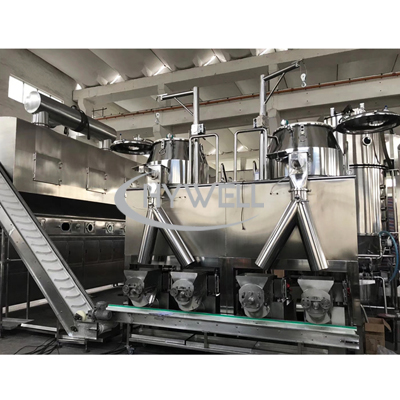
High shear granulator+Fluid bed dryer
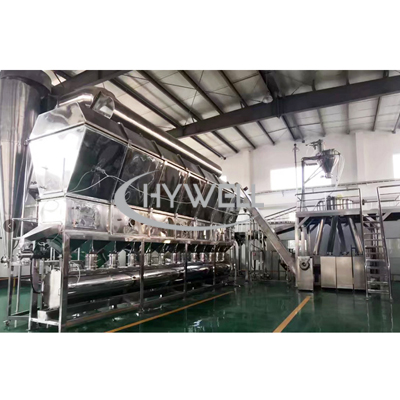 Oscillating granulator+ Continuous fluid bed dryer
Oscillating granulator+ Continuous fluid bed dryer
Static fluid dryer for instant granules line
Static fluid bed dryer video
2 T/H Continuous Granules Process Line
Static Fluidized Bed Dryer Description
A granular Fluid Drying Machine is also called a fluidized bed dryer. It consists of an air filter, heater, fluidized-bed main machine, feeder, cyclone separator, cloth bag duster (Optional), high-pressure centrifuge fan and air pipe, and control chest. Because the properties of raw materials exist differently, when equipping the dust-removing equipment, it should consider the practical needs. It can select a cyclone separator and a cloth bag duster at the same time or one of them. In general, it needs to select a cyclone separator only for raw materials that are large in specific gravity and a cloth bag duster for powder and small granule raw materials that are light in specific gravity. Meanwhile, there is an air feeding device (sending air fan) and a belt conveyor for selection. The raw material is fed into a fluidized-bed drier through the feeder. Fresh air through filtering and heating is sent to the bottom of the fluidized bed by a fan and contacts with the solid raw material on the distributing plate. In this way, the fluidized state is formed, and the heat exchange between air and solid is carried out. The dried raw material is discharged from the outlet, and the wasted gas is exhausted from the top of the fluidized bed, which catches solid powder through a cyclone separator, and a cloth bag duster. The heating system has different kinds of heating choices, such as steam, electricity, or a hot air furnace can be used. (It can be supplied as the client requests.)
The main air heating system of the static fluidized bed dryer supplies the drying chamber with the designed amount of air. The air rate is calculated with Hywell Machinery’s process calculation program. The program is based on the actual ambient conditions at the physical place where the dryer will be installed.
The main air system of static fluidized bed dryers consists of air filters, pre-heating systems, an air heater, a supply fan, and from time to time dehumidification system(Option). The main air system is constructed according to the actual requirements of the product and the ambient conditions.
Fines and air filtration system of static fluid bed dryers process, The fines coming out of the drying chamber and the external fluid bed together with the exhaust air will be separated from the exhaust air before letting it into the atmosphere.
A bag filter (option) can be a standalone solution as this technology is able to remove the required powder fines before the outlet to the atmosphere. The fines are collected in a fines return system, thereby the powder loss is reduced to a minimum. The fines can be re-entered to the top of the drying chamber, to achieve agglomeration of the powder or they can be sent to the internal or external fluid bed. Again, the required powder specifications will decide the design of the fines system.
Powder sifter (Option): The final step of the drying system is the powder sifter. The powder sifter will separate the large powder particles from the powder, size is determined for the separation. The off size is bagged off and the powder can be either directly packed into big bags or conveyed to a silo system for other packing systems.
Static Fluidized Bed Dryer Specifications
Model | Fan power(kw) | Inlet air temperature (ºC) | Exhaust air temperature (ºC) | Steam consumption (kg/h) | Electrical heater power (kw) | Water evaporated capacity (kg/h) | Size (mm) |
XF-20 | 11 | 60-140 | 40-80 | 100 | 60 | 20-25 | 2600X800X2800 |
XF-30 | 22 | 60-140 | 40-80 | 200 | 120 | 30-45 | 2600X1000X2800 |
XF-50 | 30 | 60-140 | 40-80 | 400 | 240 | 50-80 | 5000X1200X3300 |
XF-80 | 55 | 60-140 | 40-80 | 600 | 360 | 120-150 | 6000X1200X3600 |
1. Hywell machinery reserves the right to the design without notice 2. All specifications of the static fluidized bed dryer are as accurate as is reasonably possible, but they are not binding. 3 . Hywell machinery accepts non-standard customization. |
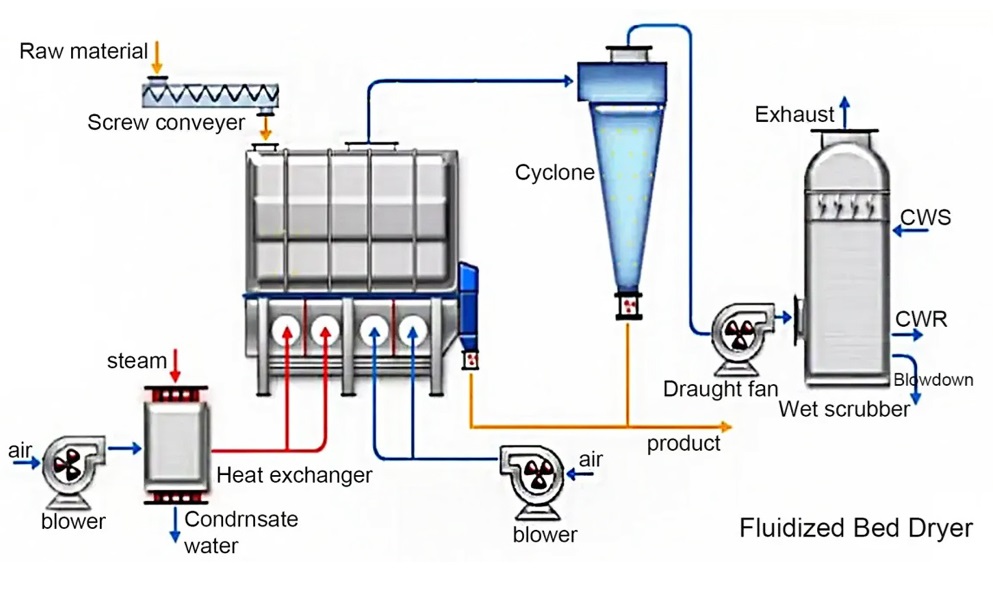
Static Fluidized Bed Dryer Construction Material
Hywell Machinery is able to offer our XF series Static fluid bed driers with contact parts to be built in SS304, SS316L, Titanium, Duplex stainless steel, etc. For the control system, Hywell has choices on push button, PLC+HMI, and so on, and For the main electrical components, it can choose the famous brand such as ABB, Siemens or Schneider, or others.
How does the Continuous Fluid Bed Dryer Work
The raw material is fed into a fluidized-bed drier through the feeder. Fresh air through filtering and heating is sent to the bottom of the fluidized bed by a fan and contacts with the solid raw material on the distributing plate. In this way, the fluidized state is formed, and the heat exchange between air and solid is carried out. The dried raw material is discharged from the outlet, and wasted gas is exhausted from the top of the fluidized bed, which catches solid powder through the cyclone separator, and a cloth bag duster.
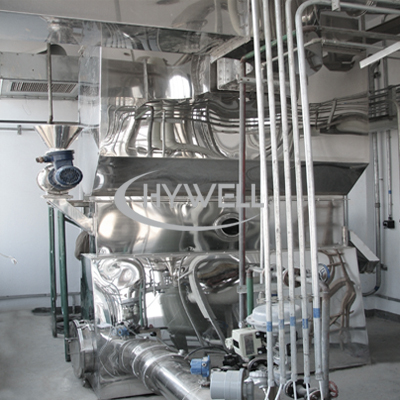
Explosion-proof fluidized bed dryer
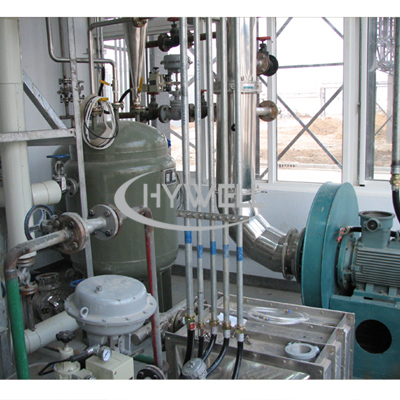 Nitrogen circulating fluidized bed dryer
Nitrogen circulating fluidized bed dryer
Static Fluidized Bed Drying Machine Advantages
Hywell machinery XF series Static fluidized bed drying machine had the following advantages over conventional solutions.
1. Low energy consumption compared to other types of dryers
2. Accurate control of the residence time, the product is dried uniformly
3. Low operating costs
4. Cooling section integrated into the dryer(option)
5. Small footprint
6. Process flexibility
7. Reliable system, less downtime
8. The feeding system for the fluid bed dryer machine can be by manual or screw feeder or conveyor belt.
9. Smooth running, reliable performance, easy operation.
10. Highly polished inner and outer surfaces of the machine, no dead comer, easy to clear, no cross-contamination.
11. Height of fluidizing chamber and dust collection can design based on client requirements.
12. Fluid bed drying is good in regulation and wide in suitability. The thickness of raw material, moving speed, and amplitude can be adjusted.
13. Fluid bed dryer process makes minimum damage to the surface of raw material. The equipment can be used for drying easily broken raw materials. The fluid bed dryer is also suitable for drying irregular shape raw material.
Fluidized Bed Drying Machine Options
1. Construction Material of the fluidized bed drying machine
We are able to offer our vibratory fluid bed dryer system with a contact part to be built in Carbon steel, SS304, SS316/316L, Titanium, Duplex stainless steel, etc. The standard of internal and external finish can be adapted to the customer’s needs.
2. Feeding & Discharge Options of the fluidized bed drying machine
Vibratory fluid bed drying systems can have a variety of feeding & discharging methods that match the demands of the filling & production line.
3. Custom Engineered Dimensions of of fluidized bed drying machine
Dimensions of our continuous fluid bed dryer can be defined according to the customer’s requirements.
4. Fluid bed drier Sizes
The fluid bed dryer has a total treat capacity with a bigger size as per request &. more.
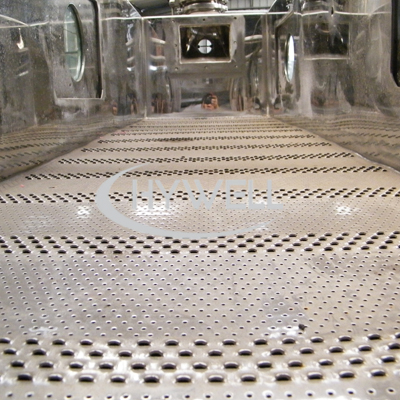
Static fluid dryer bed board
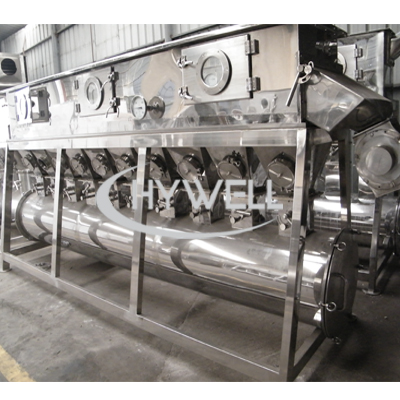
Static fluid dryer air valve
Fluidized Bed Drier Application:
The fluid bed dryer mainly has three models at Hywell machinery company, it has the static fluid bed dryer. vertical fluid bed dryer and vibration fluid bed dryer. The fluidizing dryer has been widely applied in the fields of pharmaceutics, chemicals, foodstuffs, grain processing, etc. For example, the dehumidification and drying of powder and granular materials such as bulk pharmaceuticals, granular patent medicines, preparations, feed, plastic resin, etc. The granular diameter shall be within the range of 0.1 to 6mm, and the best from 0.5 to 3mm.
The main technical parameter datum of the fluidizing dryer is for reference. Hywell also produces and designs products as per customers' requirements.

Seasoning Granules

Instant tea granules
Factors to Consider When Using a Static Fluid Bed Dryer
To achieve optimal drying results with a static fluid bed dryer, several factors need to be considered. Let's discuss the key considerations.
Product Characteristics
The characteristics of the material being dried, such as particle size, shape, and moisture content, have a significant impact on the drying process. Understanding these properties helps in selecting the appropriate drying parameters and optimizing the drying efficiency.
Desired Moisture Content
The target moisture content of the dried product is an important factor to consider. It determines the residence time required in the fluidized bed and helps in setting the appropriate temperature and airflow parameters for efficient drying. Understanding the desired moisture content is essential for achieving the desired product quality.
Air Velocity and Temperature
The velocity and temperature of the fluidizing air or gas significantly affect the drying process. Higher air velocities promote better fluidization and heat transfer, leading to faster drying. The temperature of the fluidizing medium should be carefully controlled to avoid any degradation or overheating of the product.
Residence Time
The residence time refers to the duration for which the material remains in the fluidized bed. It depends on factors such as the moisture content, particle size, and desired drying efficiency. Proper estimation of the residence time ensures that the material achieves the desired moisture content without any underdrying or overdrying.
Maintenance and Troubleshooting of Static Fluid Bed Dryers
To ensure the consistent performance of a static fluid bed dryer, regular maintenance and prompt troubleshooting are essential. Let's explore some key maintenance practices and common troubleshooting tips.
Regular Cleaning and Inspection
Regular cleaning of the fluidized bed, air distribution system, and exhaust system is crucial to prevent any blockages or buildup that can hamper the drying process. Additionally, routine inspection helps identify any worn-out components or potential issues that need to be addressed.
Monitoring Temperature and Airflow
Monitoring and maintaining proper temperature and airflow are vital for efficient drying. Regularly calibrating and checking temperature sensors, airflow meters, and control systems helps ensure accurate and reliable drying conditions.
Handling Product Variations
Different products may require specific adjustments in drying parameters. Understanding the variations in product characteristics and adapting the drying process accordingly ensures consistent and optimal drying results.
Addressing Common Issues
Static fluid bed dryers can encounter issues such as uneven fluidization, poor heat transfer, or inconsistent drying. Troubleshooting techniques, such as adjusting airflow, optimizing bed material, or modifying the heat source, can help resolve these issues and maintain optimal dryer performance.
Conclusion
Static fluid bed dryers offer efficient and versatile drying solutions for various industries. With their energy efficiency, uniform drying capabilities, and gentle handling of products, they have become indispensable in sectors such as pharmaceuticals, food, chemicals, and agriculture. By understanding the working principle, design considerations, and maintenance practices, industries can harness the benefits of static fluid bed dryers to optimize their drying processes and achieve high-quality dried products.
FAQs
What is the difference between a static fluid bed dryer and a vibrating fluid bed dryer?
A static fluid bed dryer operates on the principle of fluidization, where the particles are suspended in a fluidized state. In contrast, a vibrating fluid bed dryer uses mechanical vibration to fluidize the particles. The choice between the two depends on the specific requirements of the application.
Can a static fluid bed dryer handle heat-sensitive products?
Yes, static fluid bed dryers are suitable for heat-sensitive products. The gentle handling and precise control over drying parameters make them ideal for drying delicate materials without compromising their quality.
Is it possible to achieve uniform drying with a static fluid bed dryer?
Yes, static fluid bed dryers are designed to provide uniform drying. The fluidization of particles ensures consistent exposure to drying conditions, resulting in uniform moisture removal throughout the material.
How long does it take to dry products in a static fluid bed dryer?
The drying time depends on various factors, including the initial moisture content, product characteristics, desired moisture content, and drying parameters. Proper estimation and control of these factors determine the drying time for each specific application. It is important to conduct testing and optimization to achieve the desired drying efficiency.
Can a static fluid bed dryer be used for batch processing?
Yes, static fluid bed dryers are commonly used for batch processing. They offer flexibility in handling different batch sizes and can accommodate a wide range of materials. By adjusting the drying parameters and residence time, static fluid bed dryers can effectively dry batches of various sizes.
English
Русский
العربية
Français
Español
Português
Deutsch
italiano
日本語
한국어
Nederlands
Tiếng Việt
ไทย
Polski
Türkçe
ພາສາລາວ
Bahasa Melayu
Filipino
Bahasa Indonesia
magyar
Română
Čeština
қазақ
Српски
हिन्दी
فارسی
Slovenčina
Slovenščina
Norsk
Svenska
українська
Ελληνικά
Suomi
Հայերեն
עברית
Dansk
اردو
বাংলা
Hrvatski
Afrikaans
Gaeilge
Eesti keel
Māori
नेपाली
Oʻzbekcha
latviešu
Azərbaycan dili
Беларуская мова
Български
ქართული
Kurdî
Кыргызча

 简体中文
简体中文



























